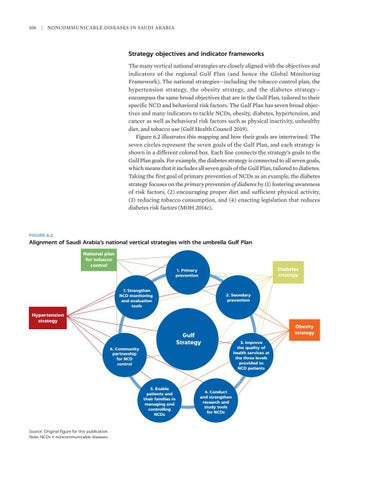106 | Noncommunicable Diseases in Saudi Arabia
Strategy objectives and indicator frameworks The many vertical national strategies are closely aligned with the objectives and indicators of the regional Gulf Plan (and hence the Global Monitoring Framework). The national strategies—including the tobacco control plan, the hypertension strategy, the obesity strategy, and the diabetes strategy— encompass the same broad objectives that are in the Gulf Plan, tailored to their specific NCD and behavioral risk factors. The Gulf Plan has seven broad objectives and many indicators to tackle NCDs, obesity, diabetes, hypertension, and cancer as well as behavioral risk factors such as physical inactivity, unhealthy diet, and tobacco use (Gulf Health Council 2019). Figure 6.2 illustrates this mapping and how their goals are intertwined. The seven circles represent the seven goals of the Gulf Plan, and each strategy is shown in a different colored box. Each line connects the strategy’s goals to the Gulf Plan goals. For example, the diabetes strategy is connected to all seven goals, which means that it includes all seven goals of the Gulf Plan, tailored to diabetes. Taking the first goal of primary prevention of NCDs as an example, the diabetes strategy focuses on the primary prevention of diabetes by (1) fostering awareness of risk factors, (2) encouraging proper diet and sufficient physical activity, (3) reducing tobacco consumption, and (4) enacting legislation that reduces diabetes risk factors (MOH 2014c).
FIGURE 6.2
Alignment of Saudi Arabia’s national vertical strategies with the umbrella Gulf Plan National plan for tobacco control
Diabetes strategy
1. Primary prevention 7. Strengthen NCD monitoring and evaluation tools
2. Seondary prevention
Hypertension strategy
Gulf Strategy 6. Community partnership for NCD control
5. Enable patients and their families in managing and controlling NCDs
Source: Original figure for this publication. Note: NCDs = noncommunicable diseases.
4. Conduct and strengthen research and study tools for NCDs
Obesity strategy 3. Improve the quality of health services at the three levels provided to NCD patients

